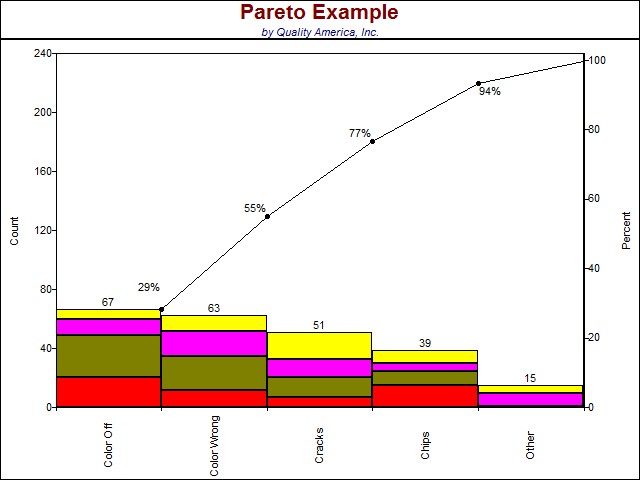Tools
7MP Management and Planning Tools
8QC Traditional Quality Control Tools
Failure Mode, Effects, and Criticality Analysis
Maintainability and Availability
Process Decision Program Charts
Interpreting a Pareto Chart

The left vertical axis of the Pareto chart has "counts" or "cost" depending on the data used. Each vertical bar represents the contribution to the total from a given "problem" area. The bars are placed on the graph in rank order, that is the bar at the left has the highest contribution to counts or cost. The right vertical axis has percent demarcations. A cumulative line is used to add the percentages from each bar, starting at the left (highest cost or count) bar. Thus, we can see which bars contribute the most problems, and with the cumulative line, determine how much of the total problem will be fixed by addressing the highest few in our Pareto chart analysis..
Remember that the purpose of the Pareto diagram is to distinguish the "vital few from the trivial many." Therefore, we would like only a few bars on the left side of the Pareto that account for most, say 80%, of the problems. Then it is clear which areas we should address. We can also look at the cumulative line to tell us if our Pareto is working well. The cumulative line should be steep, with a lot of arch to it, implying that the first few problem areas rapidly add to a high percentage of the total problems. If the cumulative line is straight, it is telling us that the contribution from each successive bar (after the first) is about even. These bars, then, should be about the same height. This says that no problems stand out as being more bothersome than the rest, which does not help much for problem solving.
We can "flatten" a Pareto Diagrams just by the way we gather our data. If we separate major problem areas into many small problem areas, than each bar will not have much in it, hence a flat shape. We might consider regrouping the problems into meaningful, larger problem areas.
Learn more about Pareto chart here:
Create and analyze a Pareto Chart in Excel
Learn more about the Quality Improvement principles and tools for process excellence in Six Sigma Demystified (2011, McGraw-Hill) by Paul Keller, or his online Green Belt certification course ($499).





